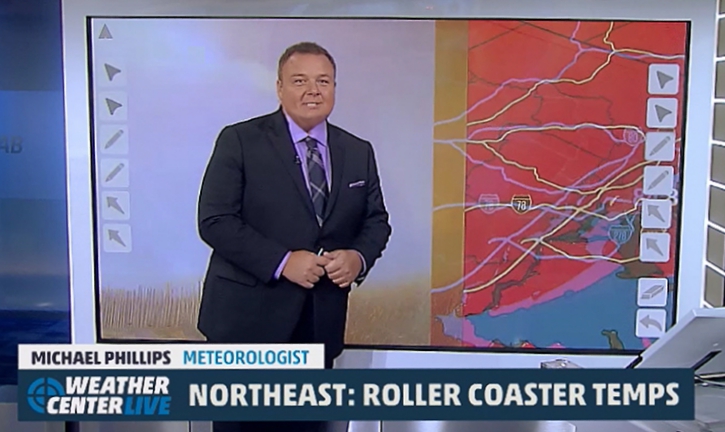Big Island Meteorologist to Observe Satellite Launch

The European Space Agency has invited Hawai‘i Island resident Michael Phillips to attend a rocket launch event at ESA headquarters in Darmstadt, Germany. Courtesy photo.
The European Space Agency has invited Hawai‘i Island resident Michael Phillips to attend a rocket launch event at ESA headquarters in Darmstadt, Germany.
Phillips, a Waikoloa resident and meteorologist, is one of just 20 people in the world invited to observe the launch from the European Space Operations Center. The launch will be lifting off the Sentinel-3B Earth Observing satellite into space on April 25.
Phillips is one of the meteorologists on the Weatherboy team that reports on weather and environmental news stories around the world, using @theWeatherboy on Twitter, theWeatherboy on SnapChat, and theWeatherboy on Facebook to communicate with more than 300,000 US-based social media followers.
Phillips attended two prior Sentinel satellite launches in Europe, earning the moniker of being a “Sentinerd” from ESA.
While the Europeans are launching this satellite, people from around the world will be able to tap into its data and imagery for free. Sentinel-3 is designed to provide continuous measurements of land and ocean temperature and color from which bio-geo-chemical products are derived, as well as ocean surface topography from which geostrophic ocean currents may be derived.

After unpacking the Copernicus Sentinel-3B satellite at the Plesetsk launch site in Russia, it was placed on the tilting dolly and put into a vertical position for testing. Over the following weeks, the satellite will be tested and prepared for liftoff, which is scheduled for April 25, 2018. Sentinel-3B will join its twin, Sentinel-3A, in orbit. The pairing of identical satellites provides the best coverage and data delivery for Europe’s Copernicus program—the largest environmental monitoring program in the world. The satellites carry the same suite of cutting-edge instruments to measure oceans, land, ice and atmosphere. PC: ESA
Each Sentinel-3 satellite carries an Ocean and Land Color Instrument (OLCI), a Sea and Land Surface Temperature Radiometer, a Synthetic Aperture Radar Altimeter and Micro Wave Radiometer. The data from these instruments feed the Copernicus Marine Environment Monitoring Service’s ocean forecasting models, and also support the environment, agriculture, and climate monitoring ongoing by the Copernicus Land Monitoring Service. Copernicus is the new name for the Global Monitoring for Environment and Security program, previously known as GMES. This initiative is headed by the European Commission in partnership with the European Space Agency. The Sentinel-3b satellite launching on April 25 will be aligned with its twin satellite, the Sentinel-3a, to provide comprehensive global coverage for Copernicus.
The beautiful blue waters off the Hawai‘i coast are key to this satellite mission’s success.
“In situ data are used for calibration, performance verification and validation of Sentinel satellite data,” said Mark Drinkwater, who heads the ESA Earth and Mission Science Division. “For example, Sentinel-3 uses the NOAA Marine Optical Buoy in Hawai‘i and the European Boussole system in the Mediterranean.”
By calibrating their sensors on these clear, colorful bodies of water, the Sentinel satellites can accurately depict the health and movement of land and sea around the planet.
Phillips doesn’t mind the more than 50 hours of travel time required to bring him from Hawai‘i to Germany for an event that’ll unfold over just minutes and hours at ESOC.

Sentinel-3B will be carried into orbit on a Rockot launched from the Plesetsk cosmodrome in northern Russia. Once safely in orbit and fully commissioned, this new satellite will begin its mission to map Earth’s oceans and land surfaces with its powerful optical and radar systems. The Sentinel-3 mission is set to play a key role in Copernicus, the world’s largest environmental monitoring program. PC: ESA/P. Carril
“The science the Sentinel-3 satellites unlock benefits humankind around the globe,” Phillips said. “Flying around the world to participate in the launch event and share that experience and knowledge with Weatherboy followers is an incredibly rewarding experience.”
Phillips flew more than 300,000 miles last year alone to cover weather events around the world, making him one of United Airline’s most frequent flyers.
“I’m proud to represent the U.S. and Hawai‘i at this event and look forward to sitting alongside other social media leaders around the world to get the word out about Sentinel-3,” Phillips added.
Sponsored Content
Comments








